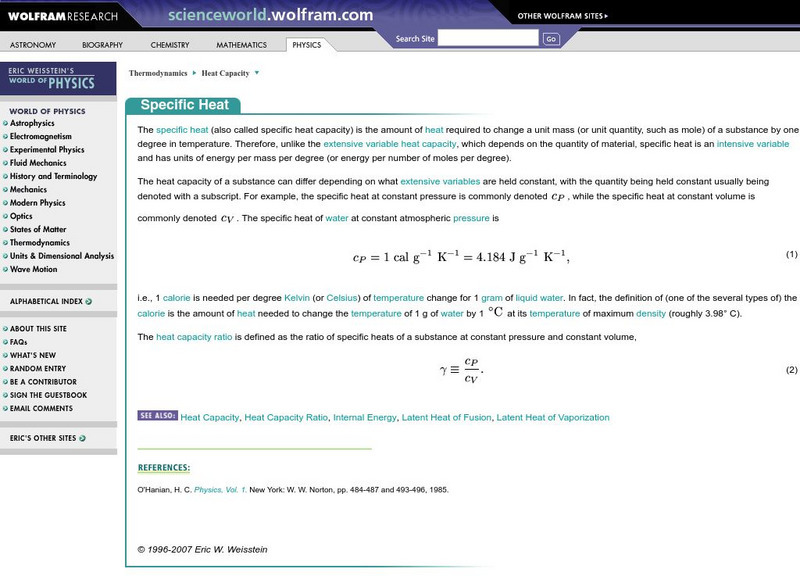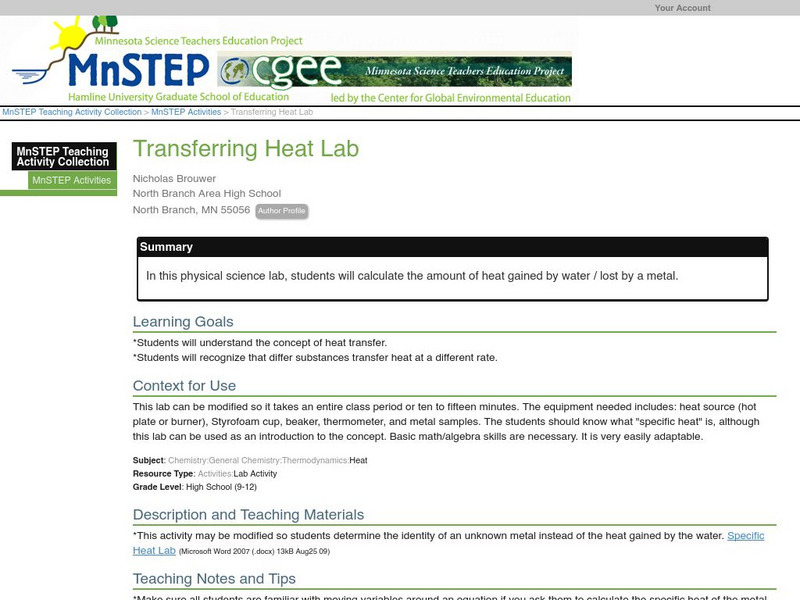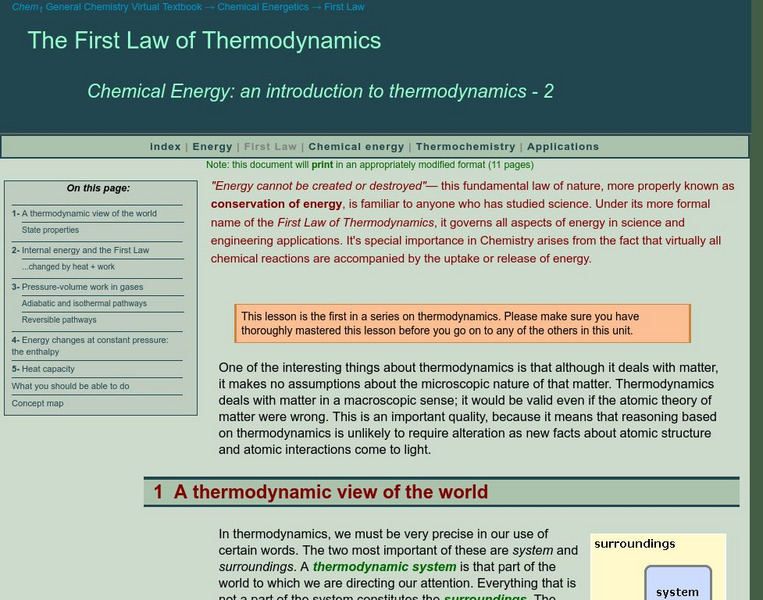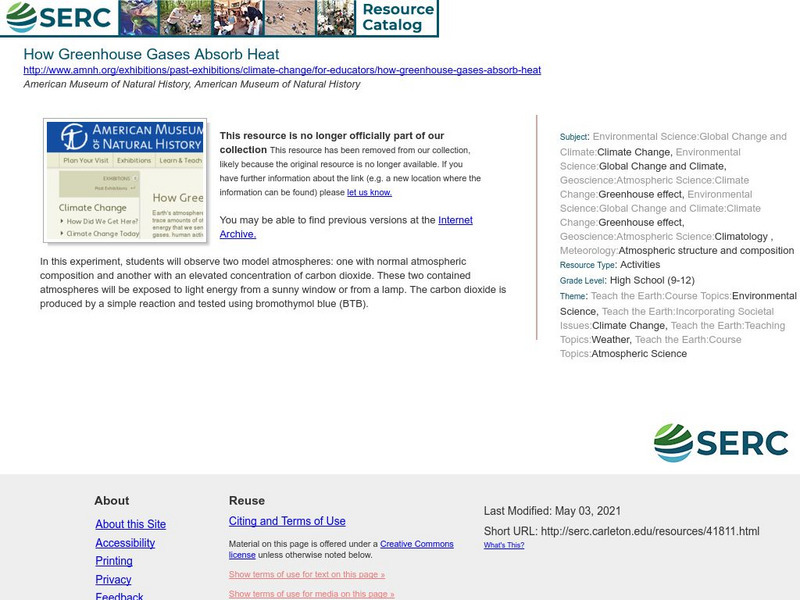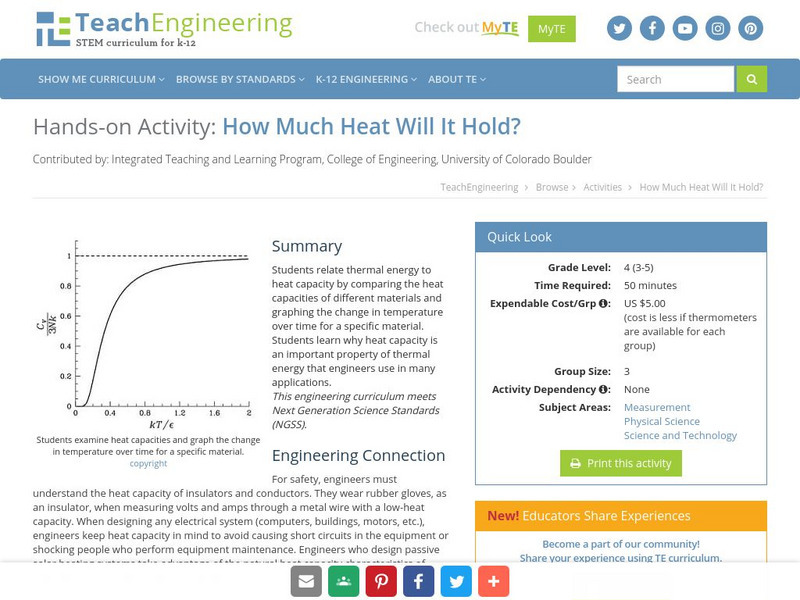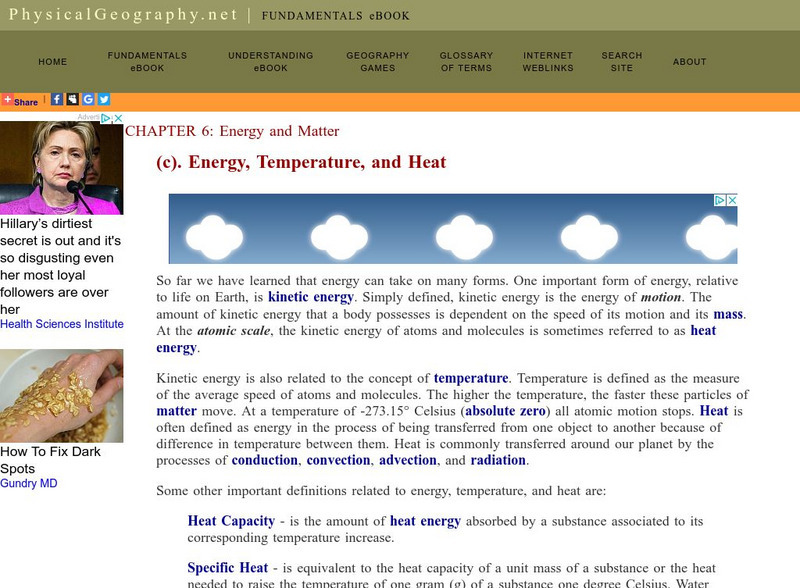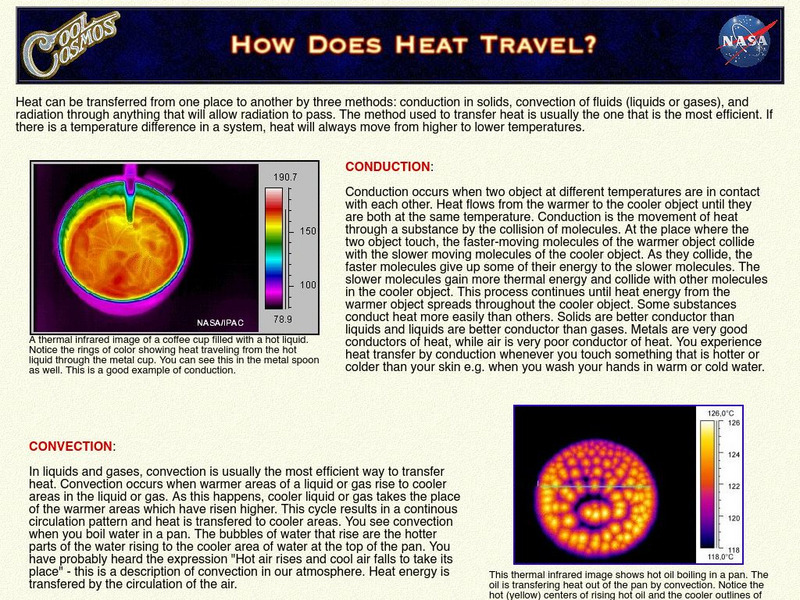Wolfram Research
Wolfram Science World: Specifiic Heat
This site has information on specific heat,the amount of heat required to change a unit mass of a substance by one degree in temperature. Included are many links and formulas.
Georgia State University
Georgia State University: Hyper Physics: Heat of Fusion
The heat of fusion is defined and described. A graphical representation of the heat of vaporization is given. A method for measuring and calculating the heat of fusion is also presented and explained.
E-learning for Kids
E Learning for Kids: Science: Kaap De Goede Hoop: What Is Heat?
Anesu lives at the Kaap De Goede Hoop (Cape of Good Hope), and is learning about sources of heat. Join her on the adventure.
Science Education Resource Center at Carleton College
Serc: Heat Transfer
Students explore how different colors absorb or reflect heat using a black can of water, a white can of water, and a plain can of water.
Science Education Resource Center at Carleton College
Serc: Transferring Heat Lab
In this physical science lab, students calculate the amount of heat transfer between water and a metal.
Simon Fraser University
Chem1 Virtual Textbook: The Heat Capacity
With an overview of topics related to chemical energetics, this site provides a foundation to a study of thermodynamics and its relation the heat capacity or specific heat.
CK-12 Foundation
Ck 12: Heat Flow
[Free Registration/Login may be required to access all resource tools.] In this lesson, students study the difference between reactions that absorb versus release heat as well as how to measure this change in energy.
Science Education Resource Center at Carleton College
Serc: How Greenhouse Gases Absorb Heat
For this experiment learners observe two model atmospheres: one with normal atmospheric composition and another with an elevated concentration of CO2. These two contained atmospheres will be exposed to light energy in a sunny window or...
Science Struck
Science Struck: Thermal Energy Facts
Explains what thermal energy is, describes some different types, and presents facts about each type.
TeachEngineering
Teach Engineering: Zero Energy Housing
Students investigate passive solar building design with a focus solely on heating. They learn how insulation, window placement, thermal mass, surface colors, and site orientation play important roles in passive solar heating. They use...
Other
Siemens Science Day: Physical Science: You're Getting Warmer
This hands-on science activity allows students to explore how materials absorb sunlight differently. Students will create model houses with different materials on the roof and see which material allows the most heat to be absorbed into...
American Chemical Society
Middle School Chemistry: Molecules in Motion
Students observe, on a molecular level, how heating and cooling affect molecular motion.
TeachEngineering
Teach Engineering: How Much Heat Will It Hold?
Students relate thermal energy to heat capacity by comparing the heat capacities of different materials and graphing the change in temperature over time for a specific material. Students learn why heat capacity is an important property...
Other
Fund. Of Phys. Geography/energy, Temperature, and Heat
A page describing (in part) the distinction between energy, temperature and heat. Includes a graphic illustrating the quantity of energy needed to transform water between various states. Methods of thermal energy transfer (convection,...
Other
U.s. Department of Energy: Photovoltaics
This site has an overview of PV technology, impact, system application and design. Information is provided on how to select the best solar system for various needs.
Georgia State University
Georgia State University: Hyper Physics: Heat and Thermodynamics
Georgia State University Physics Department privides an incredibly thorough treatment of the laws of thermodynamics. Multiple pages; many informative graphics; opportunities to practice problems and receive immediate feedback.
FT Exploring
Ft Exploring: The Second Law of Thermodynamics Equilibrium & Heat Engines
Use this illustrated guide to understand equilibrium and heat engines as they relate to the second law of thermodynamics.
US Energy Information Administration
U.s. Eia Energy Kids: Energy Units Basics
Instructions for converting the physical measurements of different types of fuels, such as gallons or barrels, to British thermal units (Btu), allowing for cross-comparison.
University of Sydney (Australia)
Thermal Physics Module: Thermal Expansion [Pdf]
A lengthy set of lecture notes on the topics of thermal expansion and heat absorption. The concept of specific heat capacity is explained and numerical examples are discussed. Heats of transformation (fusion, vaporization) are explained...
University of Sydney (Australia)
Thermal Physics Module: Refrigerators and Heat Pumps [Pdf]
Refrigerators and heat pumps are described. Their operation is explained and the variables which improve their efficiency is discussed.
University of Sydney (Australia)
Thermal Physics Module/heat Transfer 1 [Pdf]
The first of two pages discussing the different forms of thermal energy transfer. Equations expressing the rate of energy transfer by each of the methods are provided and discussed.
University of Sydney (Australia)
Thermal Physics Module/temperature and Heat [Pdf]
A lengthy set of lecture notes on the distinction between heat and temperature. The science of thermography is introduced; the Kelvin temperature scale is explained and compared to the Celsius temperature scale. The meaning of a triple...
California Institute of Technology
Nasa: Cool Cosmos: How Does Heat Travel?
An explanation, with infrared images, of how heat is transferred from one object to another.
University of Sydney (Australia)
Thermal Physics Module: Heat Engines [Pdf]
The second law of thermodynamics and the concept of entropy is applied to the topic of heat engines. The Carnot and Stirling engine are discussed. Efficiency is explained and an equation is derived.


